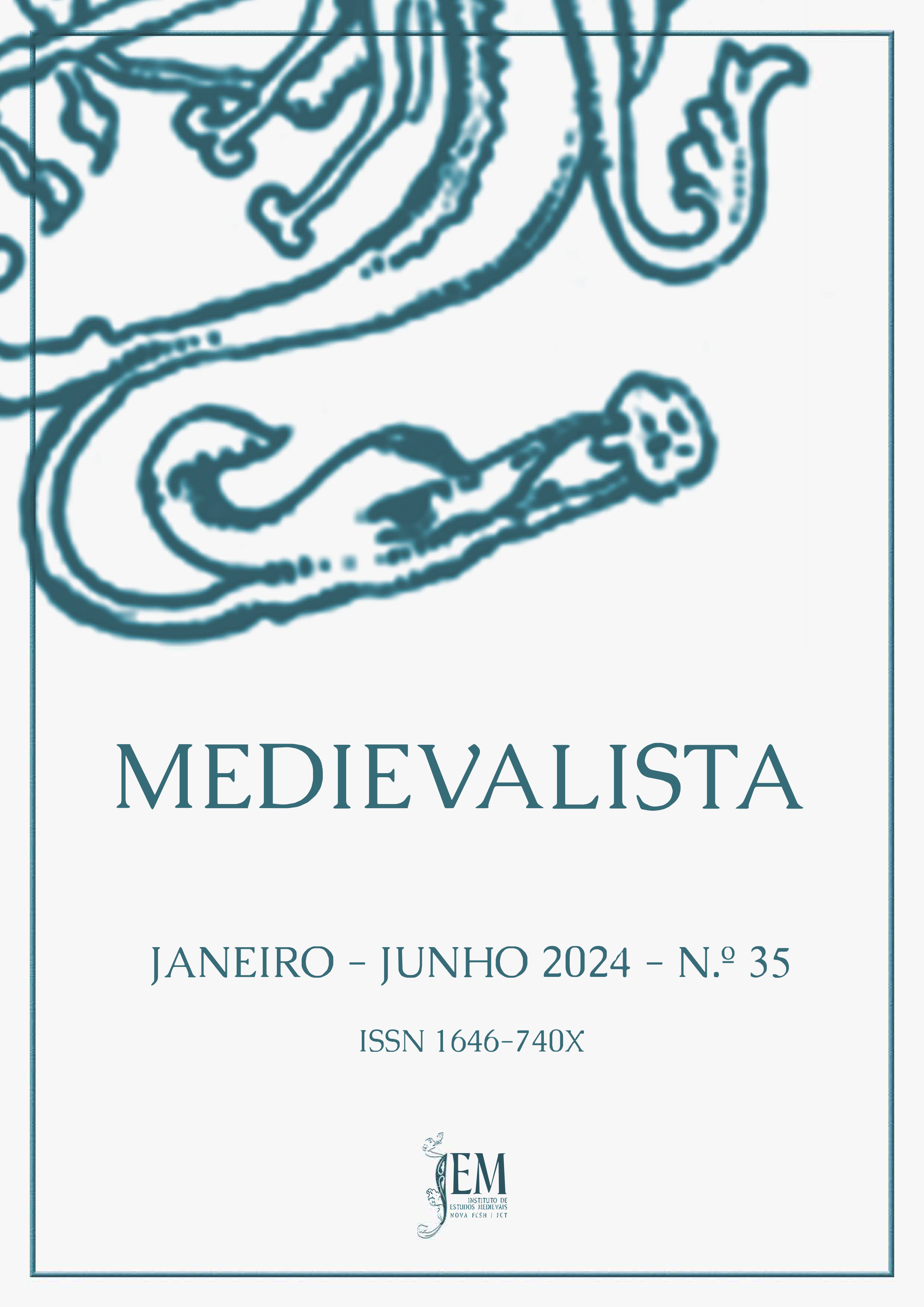The imperial capital of Mâli (14th century): A new hypothesis
DOI:
https://doi.org/10.4000/medievalista.7706Parole chiave:
Empire of Mâli, Catalan Atlas, Mansa Mûsâ, Ibn Battûta, City of MâliAbstract
Despite its international fame during the Middle Ages, our knowledge of the empire of Mâli remains patchy. Perhaps the most significant lacuna is that its capital has not yet been reliably identified. This paper offers a new hypothesis about the location of the imperial capital of Mâli in the 14th century. It is based on the observation that the rulers of Mâli, like those of other medieval African polities, strengthened their power by controlling the interface between opposite merchant networks. In doing so, they tended to establish their political legitimacy through the use of titles and displays of political and religious power befitting their different clients and subjects. Taking this economic, religious and political duality into consideration allows us to posit that the capital of Mâli lay outside the royal domain. Though it has not yet been probed by archaeology, the city’s hypothetical location proposed in this arricle corresponds to available Arabic descriptions.
Bibliographical references
Sources
Manuscript sources
Paris, Bibliothèque nationale de France, ms. Esp. 30, Atlas catalan.
Printed sources
CISSÉ, Youssouf Tata; KAMISSOKO, Wâ (ed., transl.) – La Grande geste du Mali. Des origines à la fondation de l’empire. Second edition. Paris: Karthala, 2000.
CISSÉ, Youssouf Tata; KAMISSOKO, Wâ (ed., transl.) – Soundjata, la gloire du Mali. La grande geste du Mali – tome 2. Second edition. Paris: Karthala, 2009.
CUOQ, Joseph (ed., transl.) – Recueil des sources arabes concernant l'Afrique occidentale du VIIIe au XVIe siècle: Bilād al-Sūdān. Paris: Éditions du Centre national de la recherche scientifique, 1985.
HUNWICK, John O. (ed.) – Timbuktu and the Songhay Empire. Al-Saʿdiʼs Taʼrīkh al-Sūdān down to 1613 and Other Contemporary Documents. Leiden: Brill, 1999.
LEVTZION, Nehemia; HOPKINS, J. F. P. (ed., transl.) – Corpus of Early Arabic Sources for West African History. Princeton: Markus Wiener, 2000.
MORAES FARIAS, Paolo Fernando de (ed.) – Arabic Medieval Inscriptions from the Republic of Mali: Epigraphy, Chronicles, and Songhay-Tuāreg History. Oxford: Oxford University Press, 2003.
NIANE, Djibril Tamsir – Soundjata ou l’épopée mandingue. Paris: Présence africaine, 1960.
Studies
AUSTEN, Ralph A. (dir.) – In Search of Sunjata. The Mande Oral Epic as History, Literature, and Performance. Bloomington: Indiana University Press, 1999.
BARTH, Heinrich – Reisen und Entdeckungen in Nord- und Central-Afrika, in den Jahren 1849 bis 1855. Gotha: Julius Perthes, 1857-1858.
BINGER, Louis-Gustave – Du Niger au Golfe de Guinée par le pays de Kong et le Mossi. Paris: Hachette, 1892, 2 vols.
“Cahier Koumbi Saleh”, Afrique Archéologie Arts [Online] 3 (2004-2005). Available at https://journals.openedition.org/aaa/1924.
COLLET, Hadrien – “L’introuvable capitale du Mali: la question de la capitale dans l’historiographie du royaume médiéval du Mali”. Afriques [Online] 4 (2013). Available at http://journals.openedition.org/afriques/1098.
COLLET, Hadrien – “Échos d’Arabie. Le Pèlerinage à La Mecque de Mansa Musa (724-725/1324-1325) d’après des nouvelles sources”. History in Africa 46 (2019), pp. 105-135.
COLLET, Hadrien – “Présences passées du Māli: les Māli comme horizon historique en Afrique de l’Ouest (XVIIe-XIXe siècle)”. In FAUVELLE, François-Xavier; GUTRON, Clémentine (dir.) – Passés antérieurs. À travers les strates de l’histoire en Afrique. Paris: Pétra, 2022, pp. 145-195.
COLLET, Hadrien – Le sultanat du Mālī. Histoire régressive d’un empire médiéval, XXIe-XIVe siècle. Paris: CNRS Éditions, 2022.
COLLEYN, Jean-Paul – Bamana. Milan: 5 Continents Editions, 2009.
COOLEY, William Desborough – The Negroland of the Arabs Examined and Explained, or an Inquiry into the Early History and Geography of Central Africa. London: J. Arrowsmith, 1841.
DELAFOSSE, Maurice – Haut Sénégal-Niger. Paris: Larose, 1912, 3 vols. Vol. 1: Le Pays, les peuples, les langues. Vol. 2: L’Histoire. Vol. 3: Les Civilisations.
DEVISSE, Jean; DIALLO, Boubacar – “Le seuil du Wagadu”. In DEVISSE, Jean (dir.) – Vallées du Niger. Paris: Éditions de la Réunion des musées nationaux, 1993, p. 103-115.
FAUVELLE, François-Xavier – “Niani redux. A Final Rejection of the Identification of the Site of Niani (Republic of Guinea) with the Capital of the Kingdom of Mali”. P@lethnology [Online] 4 (2012), pp. 235-252. Available at blogs.univ-tlse2.fr/palethnologie/en/2012-10-fauvelle-aymar/.
FAUVELLE, François-Xavier – “La correspondance entre Raymond Mauny et Wladislaw Filipowiak au sujet de la fouille de Niani (Guinée), capitale supposée de l’empire médiéval du Mali”. In FAUVELLE, François-Xavier; HIRSCH, Bertrand (dir.) – Les Ruses de l’historien. Essais d’Afrique et d’ailleurs en hommage à Jean Boulègue. Paris: Karthala, 2013, pp. 331-355.
FAUVELLE, François-Xavier – “African Archaeology and the Chalk-Line Effect: A Consideration of Mâli and Sijilmâsa”. In GREEN, Toby; ROSSI, Benedetta (dir.) – Landscapes, Sources and Intellectual Projects of the West African Past. Essays in Honour of Paulo Fernando de Moraes Farias. Leiden: Brill, 2018, pp. 46-62.
FAUVELLE, François-Xavier – “Ghâna, Mâli, Songhay, royaumes courtiers du Sahel occidental (VIIIe-XVIe siècle)”. In FAUVELLE, François-Xavier (dir.) – L’Afrique ancienne. De l’Acacus au Zimbabwe, 20.000 avant notre ère – XVIIe siècle. Paris: Belin, 2018, pp. 171-201.
FAUVELLE, François-Xavier – The Golden Rhinoceros: Histories of the African Middle Ages. Translated by Troy Tice. Princeton: Princeton University Press, 2018, pp. 190-199.
FAUVELLE, François-Xavier – Les Masques et la mosquée. L’empire du Mâli (XIIIe-XIVe siècle). Paris: CNRS Éditions, 2022.
FAUVELLE, François-Xavier – Penser l’histoire de l’Afrique. Paris: CNRS Éditions, 2022.
FAUVELLE, François-Xavier; HIRSCH, Bertrand – “Voyage aux frontières du monde. Topologie, narration et jeux de miroirs dans la Rihla de Ibn Battûta”. Afrique & Histoire 1 (2003), pp. 75-122. Available at https://www.cairn.info/revue-afrique-et-histoire-2003-1-page-75.htm
FAUVELLE, François-Xavier; ROBION-BRUNNER, Caroline – “Les routes de l’or africain au Moyen Âge”. In COQUERY-VIDROVITCH, Catherine (dir.) – L’Afrique des routes: histoire de la circulation des hommes, des richesses et des idées à travers le continent africain. Arles: Actes Sud-Musée du Quai Branly, 2017, pp. 82-89.
FILIPOWIAK, Władisław – Études archéologiques sur la capitale du Mali. Szczecin: Museum Narodowe, 1979.
GOMEZ, Michael – African Dominion. A New History of Empire in Early and Medieval West Africa. Princeton: Princeton University Press, 2018.
HIRSCH, Bertrand – “Écritures de l’histoire en Afrique (XIIIe-XVIIe siècles)”. In FAUVELLE, François-Xavier (dir.) – L’Afrique ancienne. De l’Acacus au Zimbabwe, 20.000 avant notre ère – XVIIe siècle. Paris: Belin, 2018, pp. 375-401.
HUNWICK, John O. – “The Mid-Fourteenth Century Capital of Mali”. Journal of African History 14 (1973), pp. 195-206.
KOGMAN-APPEL, Katrin – Catalan Maps and Jewish Books: The Intellectual Profile of Elisha ben Abraham Cresques (1325-1387). Turnhout: Brepols, 2020.
LEVTZION, Nehemia – Ancient Ghana and Mali. London: Methuen, 1973.
LY-TALL, Madina – L’Empire du Mali. Dakar-Abidjan: Nouvelles éditions africaines, 1977.
MASONEN, Pekka – The Negroland Revisited: Discovery and Invention of the Sudanese Middle Ages. Helsinki: Academia scientiarum fennica, 2000.
MAUNY, Raymond – Tableau géographique de l’Ouest africain au Moyen Âge. Dakar: Institut français d’Afrique noire, 1961.
MCINTOSH, Susan K. (dir.) – Excavations at Jenné-Jeno, Hambarketolo, and Kaniana (Inland Niger Delta, Mali): The 1981 Season. Berkeley: University of California Press, 1995.
MEILLASSOUX, Claude – “L’itinéraire d’Ibn Battuta de Walata à Malli”. Journal of African History 13 (1972), pp. 389-395.
MONTEIL, Charles – “Les empires du Mali (étude d’histoire et de sociologie soudanaises)”. Bulletin du Comité d’études historiques et scientifiques de l’Afrique occidentale française 12 (1929), pp. 291-447. Republished as: MONTEIL, Charles – Les Empires du Mali. Étude d’histoire et de sociologie soudanaises. Paris: Maisonneuve et Larose, 1968.
NIANE, Djibril Tamsir – Recherches sur l’Empire du Mali au Moyen Âge. Paris: Présence africaine, 1975.
NOBILI, Mauro – Sultan, Caliph and the Renewer of the Faith. Aḥmad Lobbo, the Tārīkh al-fattāsh and the Making of an Islamic State in West Africa. Cambridge: Cambridge University Press, 2020.
PERSON, Yves – Historien de l’Afrique, explorateur de l’oralité. Edition introduced and annotated by F.-X. Fauvelle et Cl.-H. Perrot. Paris: Publications de la Sorbonne, 2018.
POISSONNIER, Bertrand – “The Great Mosque of Timbuktu: Seven Centuries of Earthen Architecture”. In PRADINES, Stéphane (dir.) – Earthen Architecture in Muslim Cultures: Historical and Anthropological Perspectives. Leiden: Brill, 2018, pp. 22-36.
REPARAZ RUIZ, Gonzalo de – “L’activité maritime et commerciale du royaume d’Aragon au XIIIe siècle et son influence sur le développement de la cartographie de Majorque”. Bulletin hispanique 49 (1947), pp. 422-451.
SIMONIS, Francis – “L’Empire du Mali d’hier à aujourd’hui”. Cahiers d’histoire. Revue d’histoire critique [Online] 128 (2015), pp. 71-86. Available at https://journals.openedition.org/chrhc/4561.
TAKEZAWA, Shoichiro; CISSÉ, Mamadou (dir.) – Sur les traces des grands empires: recherches archéologiques au Mali. Paris: L'Harmattan, 2017.
TOGOLA, Téréba – “The Rape of Mali’s only Resource”. In BRODIE, De Neil; TUBB, Kathryn Walker (dir.) – Illicit Antiquities: The Theft of Culture and the Extension of Archaeology. London: Routledge, 2002, pp. 250-256.
Downloads
##submission.downloads##
Pubblicato
Come citare
Fascicolo
Sezione
Licenza
Copyright (c) 2023 Medievalista

TQuesto lavoro è fornito con la licenza Creative Commons Attribuzione 4.0 Internazionale.




















